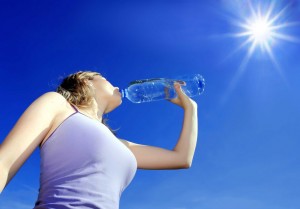What would the world be without it? Without liquid water (opposed to its frozen or gas state) we would probably be a big dry hunk of matter spinning around the sun—brown, parched and lifeless.
But fortunately the big blue globe we live in does sport life; lots of creatures big and small vibrantly exist because of water, the wonderful combination of two hydrogen atoms and an oxygen one.
The elixir of life, our cells function because water allows it. Our bodies are simply big water bottles in disguise, comprising around 75 percent of our weight and mostly found within the cells where critical metabolic processes function.
Dehydration happens when the body has more water going out than what’s coming in. Consider if the body doesn’t get any form of water for more than three days, the body starts to shut down.
It’s important to realize water is routinely lost through our lungs (12 percent), our skin via sweat to cool the body (24 percent) and to eliminate waste through urination (60 percent) or bowel movement (4 percent).
Just our metabolic process requires us to replenish with water. But add excess sweating from exercise and the hydration requirements increase. And realize alcohol is a silent partner in dehydration, causing the body to excrete excessive amounts of fluids with just one drink.
Luckily the body has its own signaling system through a thirst mechanism we all know as “being thirsty” to indicate water is needed. Soon ADH (anti-diuretic hormones) is activated that tells the kidneys to limit the amount of water in the urine making it more concentrated and yellow in color.
These symptoms are mild and not life threatening but certainly an indication that water needs to be consumed.
Secondary dehydration symptoms are extreme thirst, dryness of the mouth, eyes stop making tears, urine is dark yellow or brown, slight dizziness, cold feet and hands, increased heart rate and loss of appetite.
The tell-tale signs of severe dehydration are dizziness even when lying down, inability to get up and walk, hurried breathing, weak rapid pulse, cold and sticky skin or hot and dry skin, decreased or no urination for 12 hours or longer.
If not treated, it can lead to coma, organ failure and eventually death.
Then there is chronic dehydration, which has no acute symptoms and is more prominent than you’d expect. Some of the signs are exhaustion or lack of energy, constipation, lower back pain, and headaches. This form of dehydration also aggravates the acid/alkaline balance, leaving the body out of sync.
The body’s pH of 7.4 is maintained by keeping the cells’ hydrogen atoms at the correct concentration level. If there isn’t enough water to carry the excess hydrogen, the body becomes acidic and vulnerable to diseases.
Our joints are very much in need of keeping hydrated; if the body becomes dehydrated, so will the joints.
What is enough water to take every day? An easy ratio to remember is body weight divided by two equals the amount of ounces.
For instance, a person weighing 150 pounds would, on average, need 75 ounces of water, or a little more than 2 quarts a day.
On a hot dry day, be sure to increase that amount. And remember there is no substitute for water. Sodas or juices do contain water, but it is the pure liquid that creates the well-being we cherish, a fully functioning hydrated body to carry us through our every day life on the beautiful blue-filled waters of planet Earth.
Contact Gina at Ima_gina_tion@yahoo.com.





